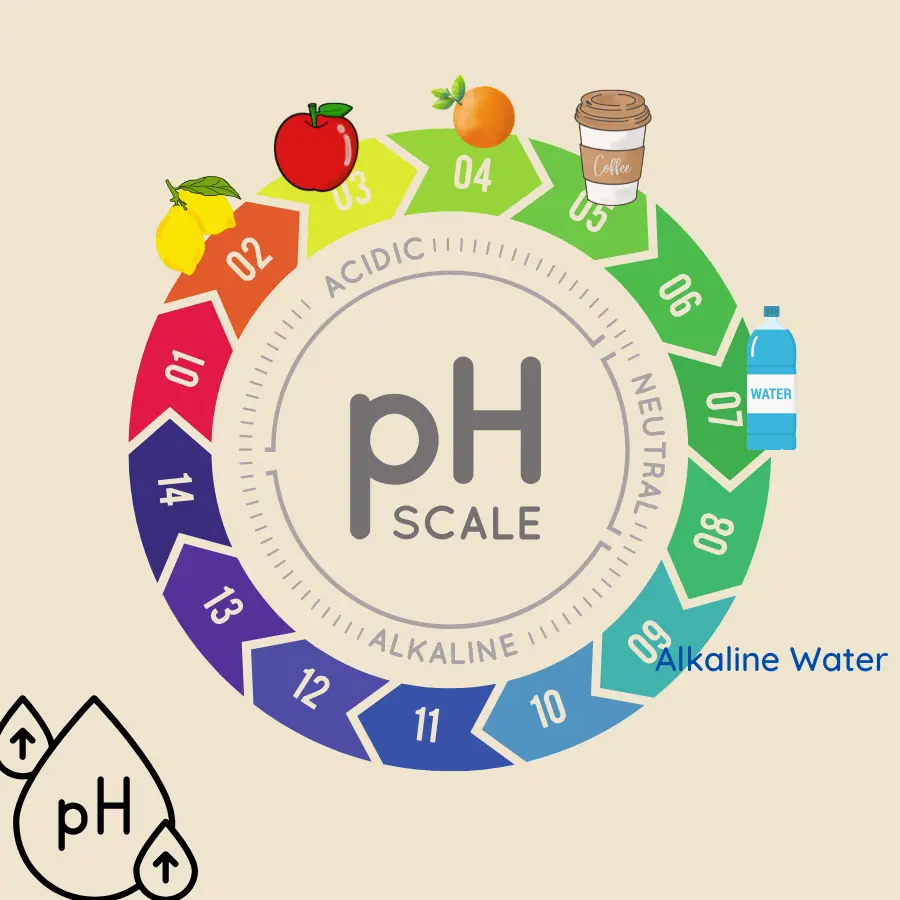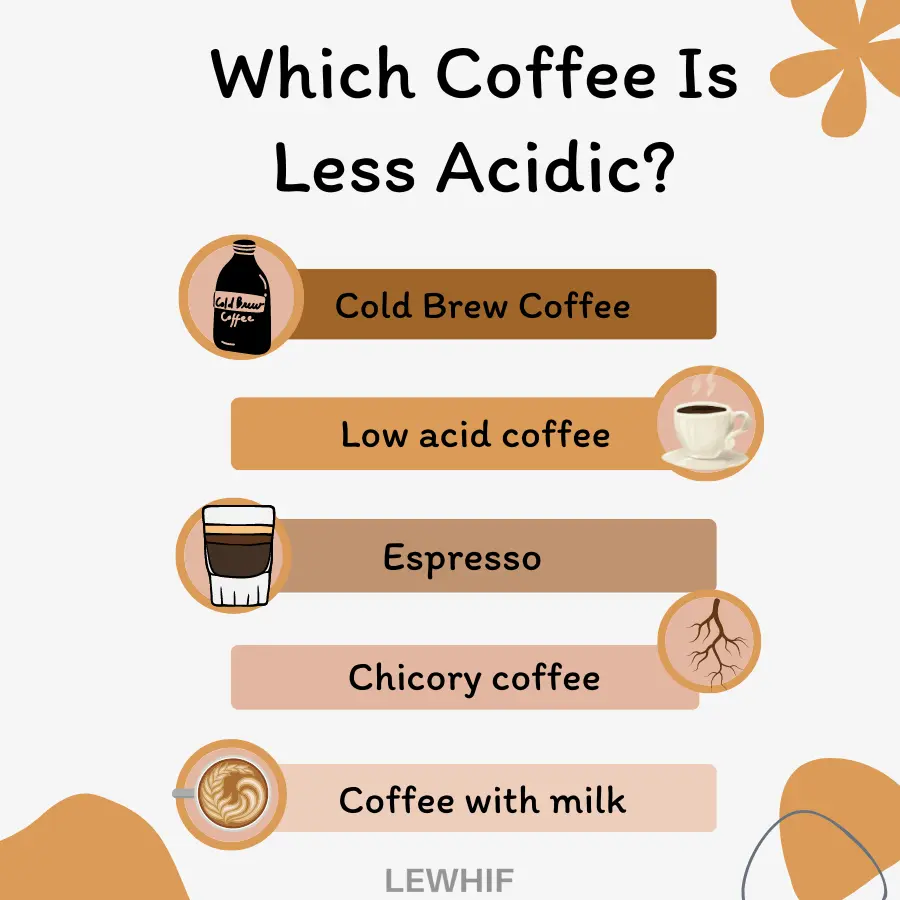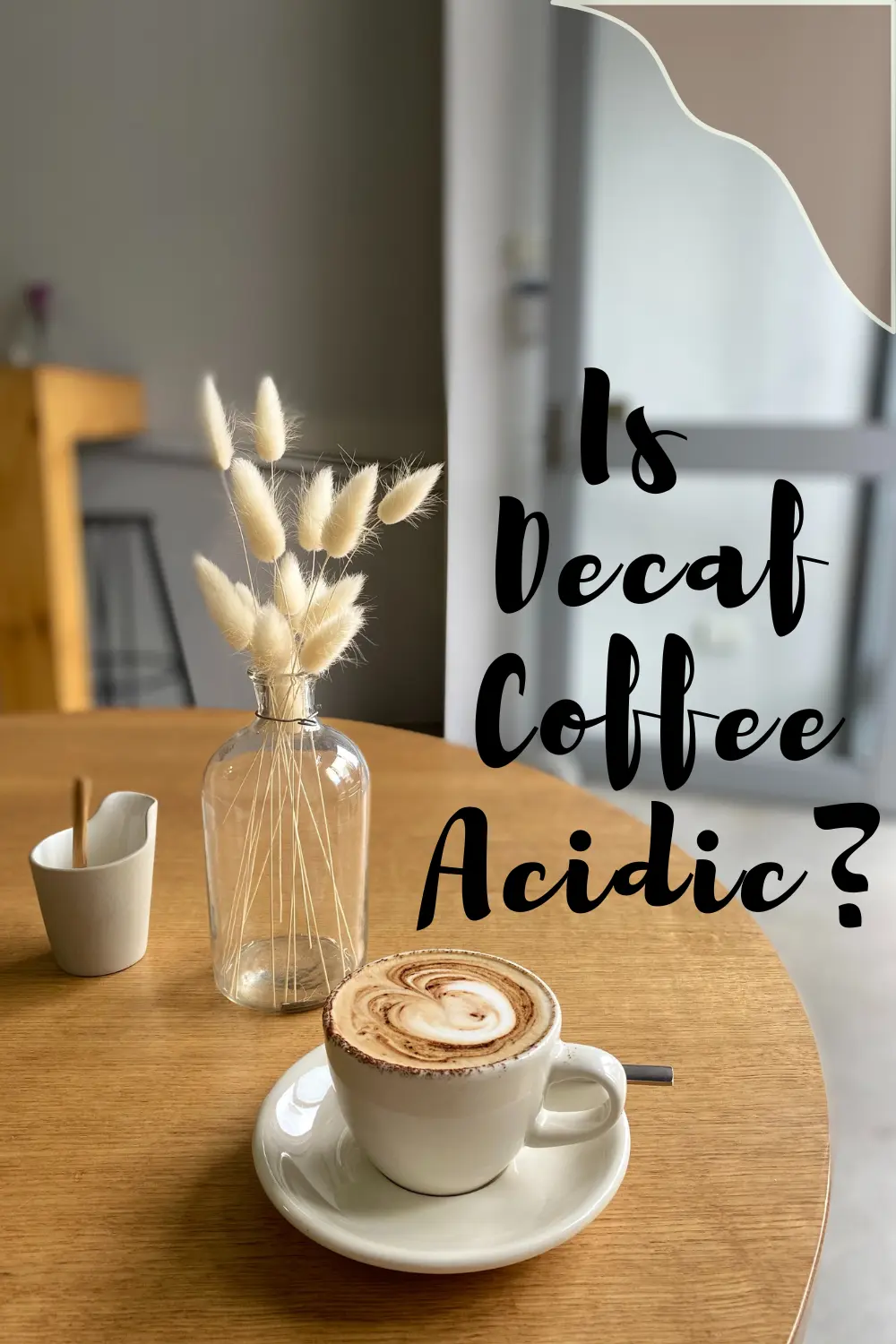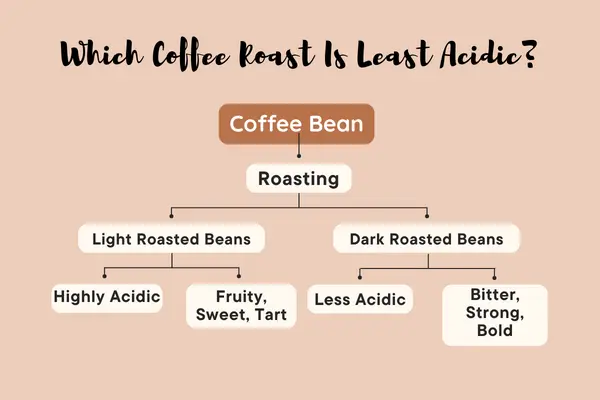Ever wondered what is this acidity in coffee? And why do people describe coffee being acidic?
Is Coffee Acidic or Alkaline?
Coffee is acidic because coffee beans contain citric and malic acids. When coffee is brewed, these acids are released from the coffee bean into the cup, which can cause acid reflux in people with sensitive stomachs. These two acids taste like lemon, orange, and apple, all of which have a lower pH than coffee. Everything with water has a pH level, and coffee’s pH level is between 4.85 and 5.10.
Water is pH neutral. Everything that is less than neutral is acidic, and everything that is more than neutral is alkaline.

What Makes Coffee Acidic?
Coffee bean is acidic due to the acids present in it. Despite the fact that coffee beans contain several acids, there are five major acids that impact the taste and acid levels in coffee. Coffee has an acidic taste due to the presence of chlorogenic acid, citric acid, malic acid, acetic acid, and quinic acid. As a result of these acids, coffee acquires a similar citrus flavor profile. Adults can have acid reflux from these acids as well.
The pH of coffee ranges from 4.85 to 5.10. Which is slightly acidic, with pH 7 being neutral. Is this to say that coffee is acidic? To put it simply, yes! Also coffee contains a significant quantity of acidity.
Acidity, on the other hand, has nothing to do with the meaning we know, yet it is a term used to describe astringent flavor and mouthfeel.
Coffee bean acids raise the pH of coffee and cause acid reflux in sensitive stomachs. Coffee beans contain two types of acids: organic acids and chlorogenic acids. The acidity in coffee is caused by organic acids, often known as OG acids. Because few OG acids have vinegar properties, they irritate sensitive stomachs and have an astringent mouthfeel.
Let me clearly explain coffee acidity, and why coffee is acidic?
Can Coffee Cause Acid Reflux?
The pH of coffee ranges between 4.85 and 5.10, which makes coffee acidic. Organic Acids present in Coffee may cause heartburn in people with Acid reflux, which is an underlying condition in few people. Components of coffee such as caffeine and acidity may trigger Acid Reflux but Coffee cannot possibly cause acid reflux.
But there are high chances if you have acid reflux and a habit of drinking coffee, it definitely worsens.
Fruits like apple and banana have a pH that is similar to that of coffee. If heartburn is not caused by eating these fruits but by drinking coffee, then the other stimulating components of coffee may be the culprit.
Though it is impossible to eliminate coffee’s acidic nature, there are ways to reduce acidity in coffee. Adding milk or creamer to coffee has been shown in studies to help people avoid acid reflux. There are acid reducers that allow you to sip your coffee black with no additional flavors while eliminating acidity. Try these alternatives to drinking coffee without creating stomach problems.
Low acid coffee beans are another alternative, these are coffee beans grown in various places that help maintain reduced acidic levels in coffee beans. And use different treated roasting methods to make it easier on the stomach.
Tyler’s organic acid free coffee is the best low acid coffee brand to try for acid reflux. This coffee has a pH of 6.2, which is closest to neutral, and a pH of 7.2 when brewed with alkaline water.
What Is Coffee Acidity?
Coffee acidity is the flavor, specifically the mouthfeel after taking a sip of coffee. Acidity is commonly described as bright, sharp, astringent, tart and sour. Acidity in coffee is an important component in describing coffee and a source of debate. It is a term used by cuppers to define a particular flavor profile.
Coffee acidity is a tricky concept to grasp because the term may also refer to a symptom in the body that causes the body to produce extra acid for digestion. However, when it comes to coffee, acidity refers to the sharpness that is felt in the mouth.
The second type of acid in coffee beans is chlorogenic acids, or CGAs, which are naturally occurring acids that contribute significantly to taste. The acids in CGAs produce a bitter taste when roasted. Higher chlorogenic acid levels in the cup are likewise associated with higher astringent levels.
Why Does Coffee Taste Acidic?
Coffee tastes acidic because of the acids in the bean. Coffee beans contain 30 different types of acids, four of which are significant organic acids that help humans taste acidity. Citrus, lime, sweet, tangy, vinegar, and sour beer characteristics are shared by citric acid, malic acid, lactic acid, and acetic acid. As a result, when coffee beans are over-roasted or under-extracted, the coffee tastes sour, astringent, and acidic.
The acidic flavor of coffee is a favorable thing to enjoy. When coffee is not acidic, it produces a weak and bland flavor. However, with the right amount of acidity, the coffee can taste bright, crisp, and sharp.
Which Coffee Is Less Acidic?
Coffee grown in different regions will yield a less acidic coffee, as would coffee beans that have been roasted to a medium to dark roast, freshly ground, steeped in water to make cold brew coffee, and served immediately without storage.
The other options to drink a less acidic coffee are listed

- Cold brew coffee is another alternative for a less acidic cup of coffee. Cold brew does not extract oils from the bean because of the steeping brewing procedure. In addition, cold brew coffee has a higher pH and is gentler on the stomach than regular brewed coffee.
- Coffee beans from various regions have distinct tastes and taste profiles. Low acid coffee beans can be found in Puerto Rico, Brazil, Indonesia, and Colombia.
- Espresso coffee prepared by using dark roasted coffee beans makes it easier to consume for heartburn.
- Low acid coffee is a quick fix for a less acidic cup of coffee, the coffee beans are grown, handled, and roasted specifically to be gentler on the stomach.
- Chicory coffee and mushroom coffee are also excellent alternatives for a less acidic option. Chicory coffee has the same flavor as dark roast coffee, but without the coffee beans. It’s a fantastic substitute for acidic coffee.
- Coffee with 2% of added milk or creamer will also make it less acidic. Because the pH of milk is 6 which is closest to neutral pH it balances the acidic properties of coffee.
Is Espresso Less Acidic Than Coffee?
Espresso is less acidic than coffee. The amount of time coffee grounds are in hot water during extraction is directly related to the acidity in coffee. During espresso brewing, the hot water is pushed through coffee grounds with pressure in a very short period of time, whereas any other brewed coffee made using the drip, french press, or pour over brewing method requires more time for brewing and a longer duration of extraction with hot water.
Espresso is often brewed with a darker roast that is already less acidic. Dark roast espresso is, in reality, the least acidic option.
Is Instant Coffee Less Acidic?
Instant coffee may be less acidic than freshly brewed coffee. Unfortunately, current research does not support this. But, to understand the fundamentals of coffee, instant coffee is this unknown coffee. We don’t know about the beans, where they are grown, how they are roasted, the brewing process, or how the shelf life is extended. The question is, what factors are sacrificed to make this quick coffee? Because instant coffee is not fresh, it irritates many people’s stomach walls, leaving them with low acid instant coffee options.
Freshly ground coffee beans retain their oils, and when brewed with hot water, they provide more caffeine, acidity, and fresh aromas to taste. However, instant coffee is simply the soluble portion of dehydrated coffee grounds sold in the market. It loses its oils, aroma, tastes, and freshness throughout this process. Caffeine and acidity, on the other hand, are difficult to truly understand.
As a best choice, instant coffee brewed with alkaline water may produce satisfactory results. Even if the qualities of an instant coffee are unclear, mixing it with a lower pH value alkaline water should be kind on the stomach. There are no studies to back this up, only a common experience. Test it out at home to see if it works for you.
Is Iced Coffee Less Acidic?

Iced coffee is less acidic than brewed coffee since it is diluted. You can also use ice cubes made from alkaline water to make it even less acidic. The magnesium and calcium minerals in the alkaline water helps coffee taste even better.
The least acidic coffee is iced coffee made from cold brewed coffee using alkaline water. Iced coffee is a coffee beverage made by using brewed black coffee, which is poured over ice cubes in a glass with or without milk. However, the brewed coffee can be made using any method.
If you’re going to get an iced coffee from a cafe, double-check the brewing procedure first. If you’re making an iced coffee at home, make sure you use cold brewed coffee for better results.
Is Cold Brew Coffee Less Acidic?
Cold brew coffee is the least acidic of the alternative choices. Because cold brew coffee is made from dark roast coffee, and studies show that dark roasts are less acidic.
However, roasting alone cannot determine the acidity of the coffee. Cold brew coffee is also less acidic due to the brewing procedure. Because studies have shown that cold brewed coffee reduces the concentration of a few organic acids in the bean. Because of this, cold brew coffee is easier on the stomach than hot brewed coffee.
Cold brew coffee reduces acidity. Cold brew does not extract bean oils due to steeping. Cold brew’s stomach-friendly pH is greater than regular coffee.
It’s shocking but an observation made by Alkaline coffee company proves that cold brew coffee made by using alkaline water has a pH of 8. Yes! It’s 8. Which is literally basic on the pH scale. It’s a 100% non acidic coffee.
Is Chicory Coffee Acidic?
Chicory coffee does not have acidic properties. It is a plant’s very alkaline root. Chicory root, when roasted, ground, and brewed like a coffee bean, produces a non acidic, caffeine-free, smooth, and full-flavored coffee. Chicory coffee tastes like dark roasted coffee. In fact, it can be added to regular coffee grounds while brewing in order to decrease acidic levels without changing the taste of the coffee.
People who follow an alkaline diet also drink chicory coffee. Alkaline coffee is a less acidic version in which the acids in regular coffee beans are eliminated and phytonutrients are added. Photo nutrients is a phyto alkaline powder and phyto energizer blend. When blended with coffee, phyto alkaline powder, which is made from extremely alkaline compounds, reduces acid levels and raises the pH. Alkaline coffee is associated with helping lower the risk of cancer and heart disease.

Is Decaf Coffee Acidic?
Decaffeinated coffee may be less acidic than regular coffee. Decaf coffee decreases caffeine in coffee. Caffeine may be a component that causes acidity, although this is still being researched. Additionally, the method of decaffeinating the bean affects the pH of coffee.
Decaf coffee has a pH of 5. Which is the closest to the pH of regular coffee. This may assist to decrease the acidity of coffee, but it is otherwise the same as normal coffee.
A decaffeinated coffee is an answer to stating less caffeine, not less acidity. If caffeine causes heartburn in some people, there is no harm in trying decaf coffee. If this doesn’t work, try drinking decaf cold brew instead. Because cold brew has less acidity and when decaf is clubbed with cold brew it might actually be less acidic.
What Coffee Roast Is Least Acidic?
Dark roast coffee has the lowest acidity of the roasts. People with acid reflux may also try medium to dark roast coffee or medium roast coffee depending on their ability to tolerate coffee acids.
“A research conducted by science news about which coffee roast is better for acid reflux have their preliminary results as stomach acids splurge for a long time when light roast coffee is consumed”
Is Light Roast Coffee Less Acidic?
The most acidic cup of coffee is light roast. People who suffer from acid reflux should avoid drinking light roast coffee drinks. Light roast coffees are roasted at temperatures ranging from 355 to 401 degrees Fahrenheit. At this temperature, the bean retains its original aromas. And the coffee oils have not yet formed on the bean. Light roast coffee tastes fruity, citrusy, sweet and tart, with a strong acidity.

The medium roast coffee has a well-balanced flavor and acidity. It is neither too acidic nor underly acidic. People with sensitive stomachs, on the other hand, should avoid drinking acidic coffee.
Is Dark Roast Coffee Less Acidic?
Dark roast coffee is considered the least acidic coffee, is gentle on the stomach, and retains all of the coffee characteristics. Dark roasted coffee beans are roasted at temperatures ranging from 440 to 480 degrees Fahrenheit. At this temperature, coffee bean oils are entirely released, and the roasting process also produces NMP, which prevents the stomach’s ability to make hydrochloric acid, reducing or eliminating stomach uneasiness. This NMP component appears to be produced in the bean during roasting. As a result, dark roasted coffee contains up to twice the NMP of light roast coffee.
A raw coffee bean seems to have the least amount of NMP.
Conclusion
Coffee is an acidic beverage. People who suffer from acid reflux should avoid drinking coffee. However, if this is not possible, there are a few things that can be done to lower the acidity of coffee. Low acid instant coffee is the best option to attempt, but if you wish to brew coffee on your own and make the coffee less acidic, choose medium to dark roasted low acid coffee beans and brew it cold. Experiment with espresso and alkaline water, or iced coffee and alkaline water. Chicory coffee is a great way to avoid both caffeine and acidity. If you want caffeine but not acidity, try green tea, while it is not a substitute for coffee, it is an option to consider.
Drinking coffee in a preferred style is a unique taste. Try any method, from alkaline water to dark roast, alter it as desired, and sip the perfect cup crafted just for you.
Frequently asked questions
Is Coffee Bad For Teeth?
Coffee is incredibly damaging to your teeth. Coffee not only discolors the teeth to a yellowish dent, but it also causes cavities, foul breath, and enamel loss. Enamel is the outer coat of the teeth that protects and maintains their health. Drinking coffee also promotes the formation of cavities. There have been studies conducted on this issue.
- The acidic component of coffee causes enamel erosion. As one’s coffee addiction grows, the enamel on one’s teeth thins, resulting in tooth sensitivity.
- When the acidity of coffee is mixed with enamel loss, the teeth turn yellow.
- Adding sugar to coffee to mask the bitterness reduces your ability to prevent dental decay. Polyphenols lose their antibacterial capabilities as a result of these additions.
Is Tea Less Acidic Than Coffee?
The most well-known black tea is just as acidic as black coffee. To be safer with acid reflux, it is better to have green tea, mint tea, chamomile tea, fennel tea and herbal tea. Green tea being the most healthy of all. Closest to alkaline water, subtle on stomach.
Tea comes from all over the world and comes in thousands of different types. Green tea and chamomile tea are the least acidic teas, having pH levels closest to water. Green tea contains high levels of caffeine, similar to coffee, but chamomile contains no caffeine and has the lowest acidity. At the same time, lemon tea and rosehip tea are much higher to the pH level of brewed coffee. Rosehip tea, being the most acidic of all, follows in the footsteps of lemon tea.
In moderate consumption, even kombucha tea is a best option.
Reference
- https://www.tandfonline.com/doi/full/10.1080/10408398.2021.1957767
- https://sca.coffee/sca-news/2021/10/19/acids-in-coffee-a-review-of-sensory-measurements-and-meta-analysis-of-chemical-composition
- https://www.acs.org/pressroom/newsreleases/2010/march/brewing-up-a-gentler-java-dark-roasted-coffee-contains-stomach-friendly-ingredient.html
- https://www.nature.com/articles/s41598-018-34392-w
- https://www.ncbi.nlm.nih.gov/pmc/articles/PMC7404565/
- https://www.usgs.gov/media/images/ph-scale-0